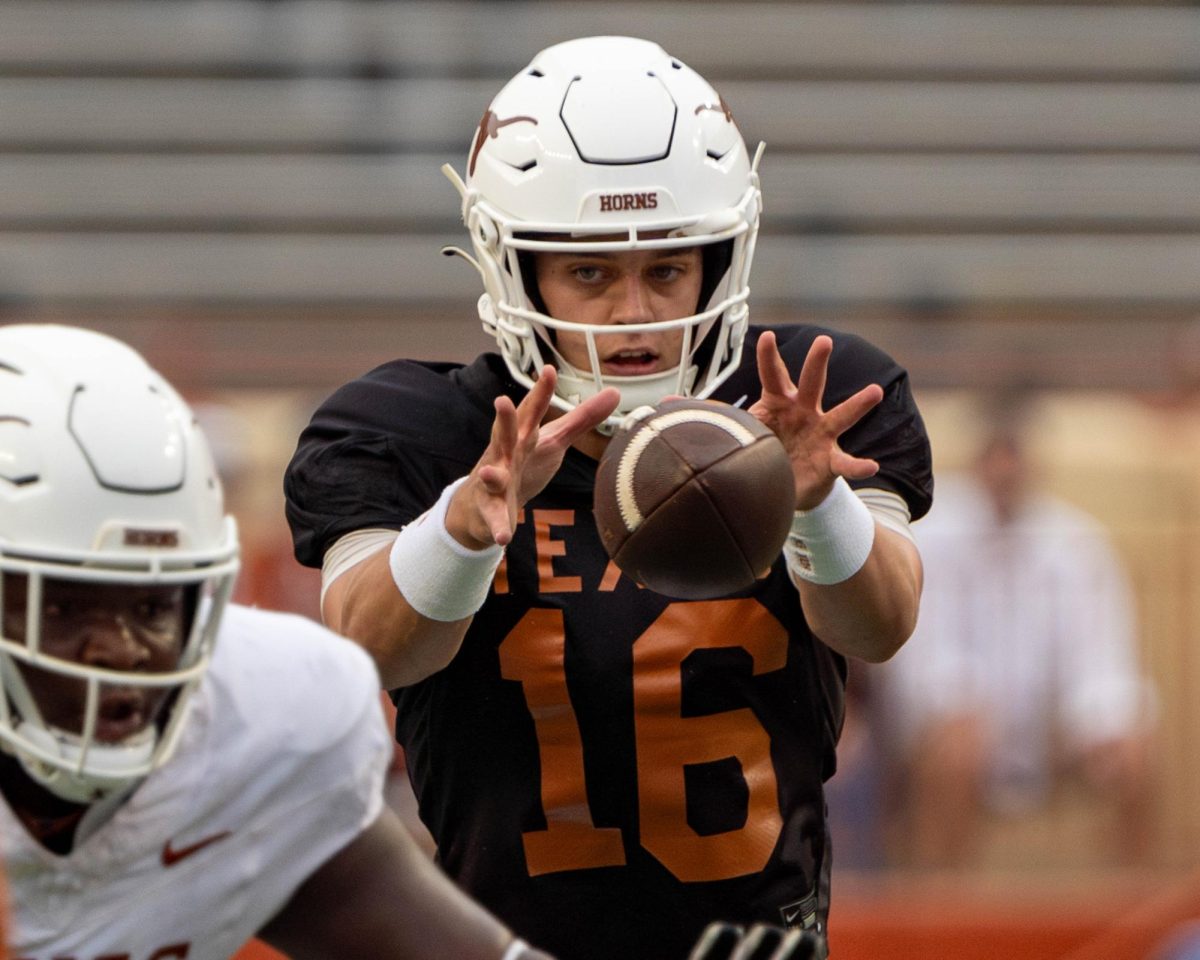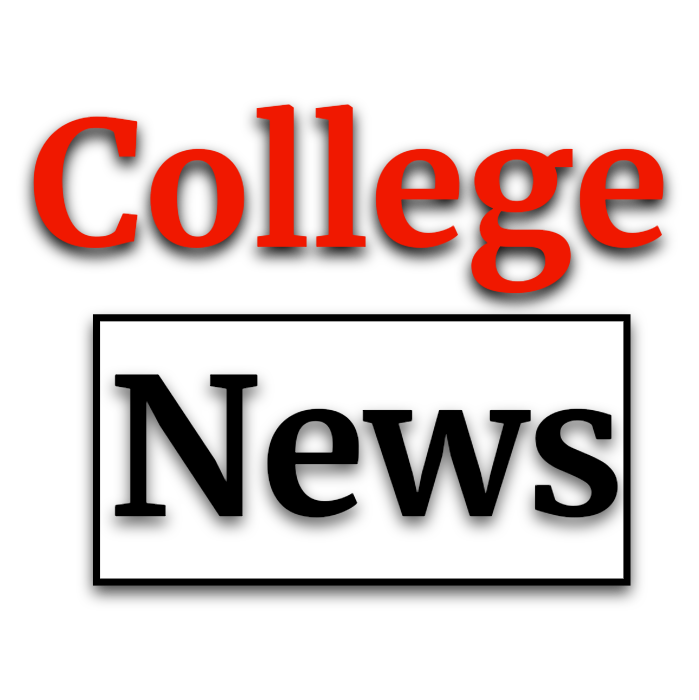REPORTS: NCAA Levels the Field: Coach-Player Headsets Revolutionize College Footbal…
NCAA Levels the Field: Coach-Player Headsets Revolutionize College Footbal…
April 23, 2024.
QB2 Arch Manning catches a snap during Texas’ annual spring game on Saturday.
All 22 players are staring toward their respective sidelines as the play clock is running out, and they are all focused on finding the forthcoming play call signal. Many persons in various colored shirts are performing various hand gestures and movements to keep the signal secret, but only one of them has the play call.
Those times are gone.
The play clock is winding down, and all 22 players are looking toward their respective sidelines, intent on locating the next play call signal. Only one person has the play call while many others in different colored shirts are making different hand motions and moves to conceal the signal.

Those days are long gone.
Throughout the 2023 season, Texas head coach Steve Sarkisian pushed for this modification. He made use of the communication systems while playing for the Atlanta Falcons in his brief NFL career from 2017 to 2018.
With the new technology, a coach can wear a headset with a microphone that plugs straight into a speaker in a player’s helmet. The helmet, which has a green dot on the back, will be worn by the quarterback and a designated defensive player when they are on the field.
On Nov. 16, Sarkisian made his stance on in-helmet communication clear.
“Everybody write an article about ‘Why doesn’t college football have coach-to-player communication?,’ so I don’t have to deal with sign-stealing,” Sarkisian said. “I spend half of my week changing signals and signs rather than coaching the game of football. So please, write an article.”
This statement was made on the same day that Michigan head coach Jim Harbaugh stated he would be taking a three-game suspension to avoid facing an investigation from the conference, and days later the Big 10 declared it would be disciplining him. The final three regular-season games of his squad, against Penn State, Maryland, and Ohio State, were played without Harbaugh on the sidelines.
ESPN reports that Harbaugh was punished for “conducting an impermissible, in-person scouting operation over multiple years, resulting in an unfair competitive advantage that compromised the integrity of competition,” a violation of the Big 10’s sportsmanship rules that led to his suspension.
However, his team was completely unaffected by his suspension. Harbaugh and the Wolverines raised the trophy for the College Football Playoff National Champion
ship on January 8, 2024. For much of the season, Michigan was the best college football team, but not without controversy.
With the addition of coach-to-player headsets, sign stealing will be virtually eliminated from the sport.
“It all makes sense to me,” Sarkisian said. “There’s no shortage of money in college football, clearly. That whole idea that it’s a competitive disadvantage for those (universities) that can’t do it, or that stadiums aren’t equipped to have that type of technology, I don’t buy it. I don’t understand it.”
Sarkisian is a strong proponent of acquiring the new technology and preparing to play for the upcoming season because he thinks it is the ideal solution to the sign-sealing conundrum.
“We’re talking about sign-stealing? Like, let’s just fix the problem,” Sarkisian said. “Let’s get player-to-coach communication and move forward.”

It is precisely what the NCAA is carrying out. On March 1, the NCAA Football Rules Committee suggested a rule pertaining to coach-to-player communication. Since then, coaches—including Sarkisian—have been permitted to utilize the headsets during spring sessions.
The NFL’s in-helmet communication devices, in which the quarterback can hear the coach and one defensive player’s helmet has a speaker installed, will be strikingly identical to these. The NCAA states that when the play clock reaches 15 seconds or the ball is snapped, whichever happens first, the communication system in the helmet will turn off.
Apart from the in-helmet communication technologies, teams would have the capability to examine plays using up to eighteen iPads. The tablets in the locker room, coaching booth, and sideline will be accessible to the coaches.
Sarkisian wasted little time in getting to work with the scheme with redshirt junior quarterback Quinn Ewers on March 19 during the first spring session. The biggest change for Ewers will be hearing the play call right in his ear rather than needing to glance to the sidelines. Sarkisian began acclimating Ewers to the sidelines as soon as possible, even though he expects him to continue looking to the sidelines and isn’t giving up signs entirely.
Sarkisian is aware that he will have to adapt to Ewers’ ease of information feeding.
“The challenge for me is how much information is quality, good information,” Sarkisian said. “When does it cross the threshold of too much to where it’s a little bit of paralysis by analysis?”
More effects on the games than may be directly advertised will come from the coaches and quarterbacks’ direct communication. It will eliminate the ability to steal signs and also have the ability to control the game’s speed. It will also assist college quarterbacks get ready for the NFL, where this technology has been around for roughly 20 years.
Ewers rapidly adjusted to wearing the headset, which he began using on the first day of spring practice.
“I love it,” Ewers said. “I think it makes things a little bit easier for me. Obviously, we’re still signaling, but I still have Sark telling me the plays in the helmet. The first day was a little shaky just because I was getting used to it, but I think it’s gonna be really helpful for me.”
Following the 2023 season, Ewers decided to return to Texas for his third year with the hopes of being as prepared as possible for professional football. With the use of the headsets, teams will not have to worry about getting Ewers and other future quarterbacks adapted to using the headsets.
“It’s only gonna help,” Ewers said.
Similar effects of the communication system will be seen on the defensive side of the ball. Defenses won’t be caught scrambling to get signals or get the play call in before the ball is snapped when offenses set the tempo of the game.
The defenses will be able to match the speed and not be caught looking for a fresh play call in addition to the fast-paced offenses and no-huddle schemes.

Although senior linebacker David Gbenda anticipates not wearing the helmet with the coach-to-player communication system, he is excited about the potential influence it will have on the game.
“I feel like it’ll make (the game) faster,” Gbenda said. “Instead of me having to look to the side, I’m just looking at the offense. … I’m seeing what they’re giving me, understanding the body language of the linemen, the body language of the receivers, so I can have a tidbit of pick up on the players. I feel like it would just make the game a lot faster and easier to pick up.”
Although managing the game’s tempo has always been a strategy, teams will now be able to do so more effectively because coaches may now call plays fast rather than gesturing them.
While fans may not notice the difference, players and coaches will. These headsets will have an impact on college football games. Players will now have one less concern to worry about as they get ready for the NFL draft, bringing them one step closer to the NFL.
The addition of the two-minute warning, an automatic timeout that happens in the second and fourth quarters when the clock reaches two minutes, is another way that college football is following the NFL’s lead.
These modifications will have a wide range of effects on the game, and following a season marred by controversy over sign-stealing, the communication systems will compel coaches to modify their scouting strategies. Hopes are high for the new offense and its capacity to grow with the new technology for a squad that features one of the top quarterbacks under center and an exceptional offensive mind behind the microphone.

